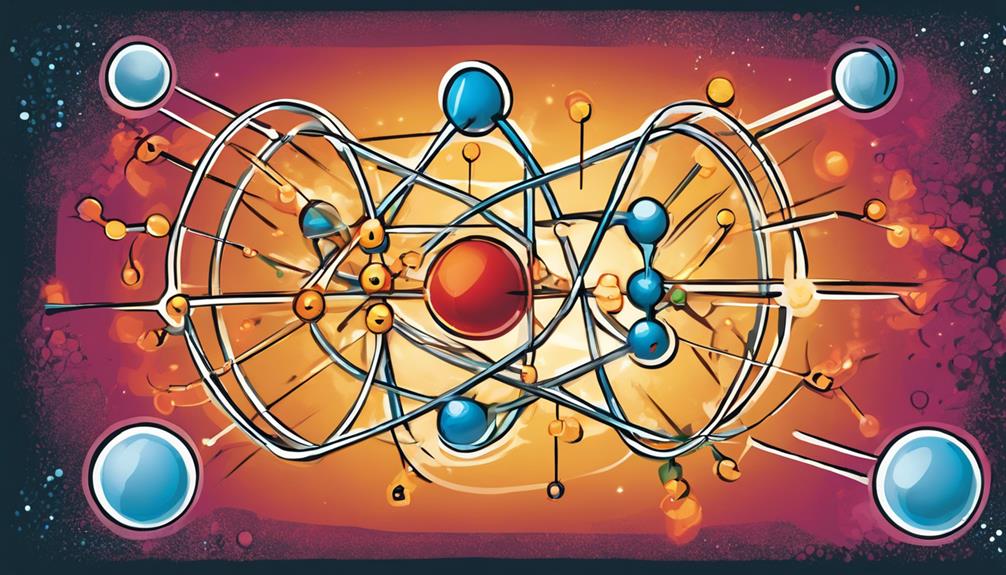As we explore the Earth's crust, we're struck by geothermal energy's vast, unutilized potential. A staggering 95% of the planet's heat energy remains out of reach, waiting to be utilized. To reveal these depths, we need to comprehend the factors influencing geothermal energy potential, including depth variations and rock type. We'll immerse ourselves in the benefits of tapping deeper reserves, exploring methods like superdeep drilling and advanced binary power plants. But we'll also face technical challenges and environmental impact concerns. By grasping these essentials, we can unleash the secrets of geothermal energy and discover a cleaner, more sustainable future – and there's still so much more to explore.
Key Takeaways
- Geothermal energy potential increases with depth, offering greater temperature and energy output at deeper levels.
- Understanding rock type and temperature gradient is crucial for determining geothermal potential and energy output.
- Drilling techniques, such as directional drilling, and heat transfer fluids are essential for efficient geothermal energy extraction.
- Tapping deeper geothermal reserves can increase energy output, reduce heat loss, and minimize greenhouse gas emissions.
- Overcoming technical challenges, such as drilling costs and equipment damage, is critical for successful geothermal energy exploration and sustainability.
Geothermal Energy Potential Analysis

As we delve into the realm of geothermal energy, analyzing the potential of this renewable resource becomes essential. Understanding the factors that influence it is key to accessing its full capacity. It's recognized that geothermal energy potential varies with depth, with deeper levels generally offering greater potential due to increased temperature.
Rock type, temperature gradient, and proximity to heat sources also play a pivotal role in determining the depth range required for accessing geothermal energy. By comprehending these factors, we can pinpoint areas with high geothermal potential and optimize our exploration efforts.
This analysis is crucial in unleashing the full potential of geothermal energy and harnessing its power to combat climate change.
Depth Variations and Feasibility
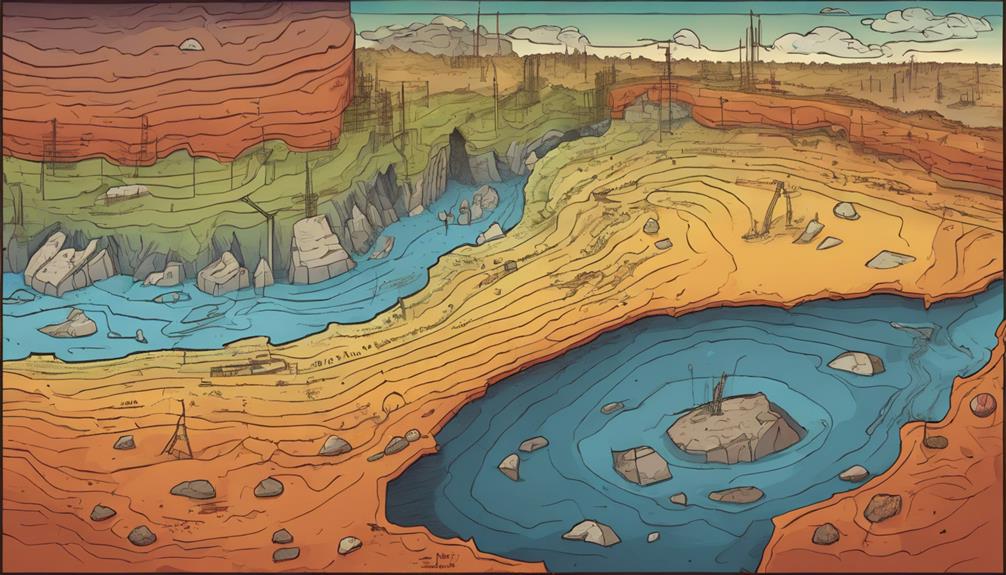
We'll take a closer look at how depth variations impact the feasibility of geothermal energy extraction, examining the specific depth ranges that offer promise for harnessing this renewable energy source.
The geothermal gradient, indicating the temperature increase with depth, plays a key role in determining the feasibility of geothermal energy extraction. Different depths, ranging from shallow systems at 10-100 meters to superdeep drilling at 5-10 kilometers, offer varying levels of geothermal potential and energy output.
Understanding depth variations is essential for maximizing geothermal energy as a renewable source. By exploring these depth ranges, we can open up the full potential of geothermal energy, making it a viable option for sustainable power generation.
Tapping Deeper Reserves Benefits

Drilling into deeper geothermal reserves can greatly boost energy output, efficiency, and lifespan, making it a promising strategy for maximizing the potential of this renewable energy source. While initial costs may be higher, the benefits far outweigh the drawbacks. Deeper reservoirs emit minimal greenhouse gases, contributing to combating climate change. We can tap into these reserves using advanced drilling techniques and excavation technologies.
| Benefits | Description |
|---|---|
| Increased Energy Output | Higher temperatures at greater depths result in more energy generation |
| Improved Efficiency | Deeper reservoirs lead to higher conversion rates and reduced heat loss |
| Extended Lifespan | Deeper systems can operate for longer periods, reducing maintenance costs |
| Environmental Benefits | Minimal greenhouse gas emissions contribute to a cleaner environment |
| Economic Viability | Higher energy output and efficiency lead to increased economic returns |
Geothermal Extraction Methods
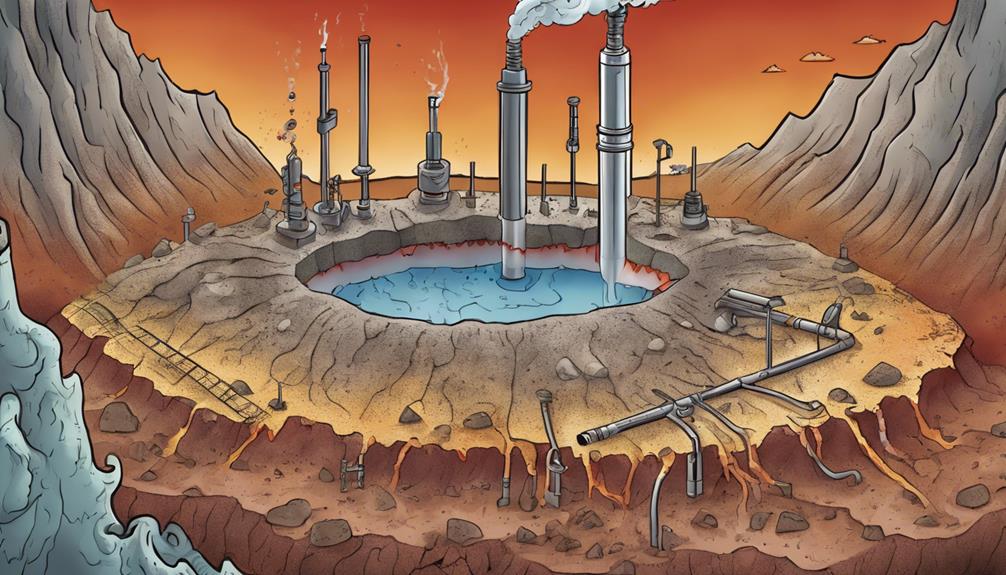
Heat transfer fluids play an essential role in geothermal energy extraction, efficiently transferring thermal energy from underground reservoirs to the surface for power generation. We rely on drilling techniques like directional drilling and hydraulic fracturing to access these reservoirs.
Once we've tapped into the heat, we use geothermal power plants and heating systems to convert it into usable energy. Our goal is to maximize efficiency, so we're constantly improving our methods. Advanced binary power plants, higher conversion efficiencies, and cutting-edge heat exchangers all help us get the most out of the Earth's heat.
Efficiency Enhancement Strategies

To squeeze every last bit of energy out of the Earth's heat, we're continually refining our efficiency enhancement strategies, from enhancing fluid flow rates to implementing cutting-edge turbine designs. Our goal is to maximize the amount of electricity generated from each liter of hot water or steam extracted from the ground.
Some of our key strategies include:
- Cutting-edge binary cycle power plants: These allow us to harness heat from lower-temperature reservoirs, making more sites viable for geothermal energy production.
- High-temperature materials: New materials that can withstand extreme temperatures are enabling us to tap into hotter, more energetic reservoirs.
- Improved heat exchangers: Enhanced designs are allowing for more efficient heat transfer between the hot fluids and the power generation equipment.
- Strategically placed wells: Careful planning of well locations and trajectories helps to minimize losses and maximize energy output.
- Real-time monitoring and control: Advanced sensors and automation systems enable us to fine-tune our operations in real-time, ensuring top-notch performance and efficiency.
Overcoming Technical Challenges
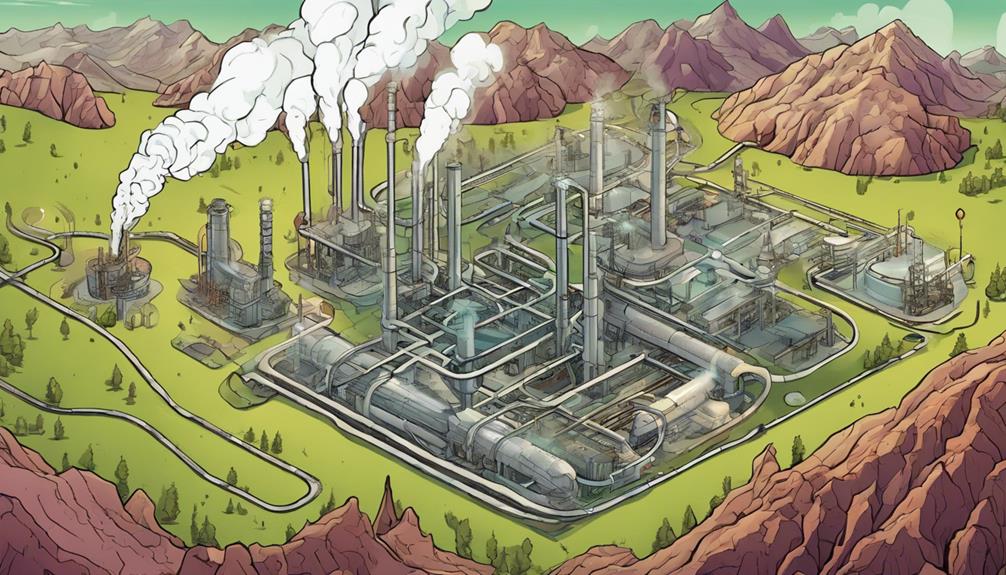
We're now pushing beyond the efficiency enhancement strategies to tackle the technical challenges that have long plagued the geothermal energy industry. As we explore deeper into the Earth's crust, we face significant obstacles. Drilling costs skyrocket, equipment damage risks increase, and complex geological conditions test our expertise.
To overcome these hurdles, we must invest in research and development, improving our drilling techniques and equipment durability. Advanced sensors and monitoring systems can help us navigate treacherous underground terrain. By addressing these technical challenges, we can uncover the full potential of geothermal energy, making it a more viable and sustainable option for our planet's future.
Environmental Impact Mitigation
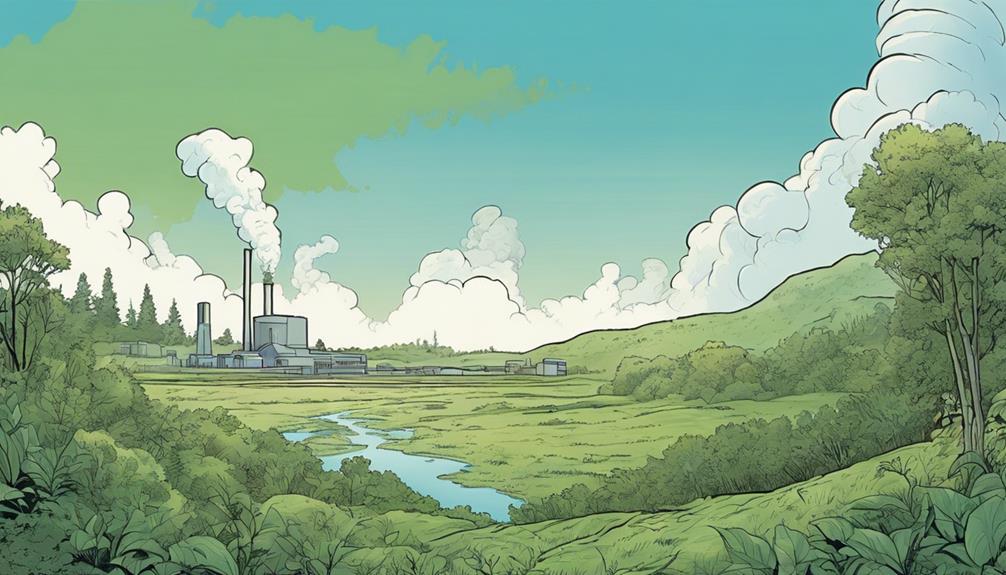
As geothermal energy exploration ventures deeper into the Earth's crust, it's our responsibility to mitigate the environmental impacts associated with drilling and extraction, ensuring that this clean energy source remains a sustainable option for generations to come.
We must take proactive measures to minimize the risks of groundwater contamination, land subsidence, and induced seismicity.
Here are some key strategies we're implementing:
- Conducting thorough environmental impact assessments to identify potential risks
- Implementing closed-loop systems to prevent groundwater contamination
- Using cement and casing to secure wells and prevent leaks
- Monitoring and managing induced seismicity through real-time data analysis
- Developing and utilizing environmentally friendly drilling fluids and materials
Geothermal Energy Conversion Basics

We harness the Earth's heat by converting it into electricity through geothermal power plants, which rely on high-pressure steam to drive turbines and generate power. This process begins with drilling into underground reservoirs to access hot water or steam.
We then pump this heat transfer fluid to the surface, where it's used to power turbines connected to generators. As the steam expands through the turbine, it drives the generator to produce electricity.
After passing through the turbine, the cooled fluid is re-injected into the ground, maintaining the reservoir's temperature and ensuring a sustainable energy source. By understanding these conversion basics, we can better appreciate the potential of geothermal energy to power our future.
Frequently Asked Questions
How Does Geothermal Energy Compare to Other Renewable Energy Sources?
"We're often asked how geothermal energy stacks up against other renewables. Honestly, it's a unique gem, offering consistent baseload power with minimal emissions, making it a valuable addition to the renewable energy mix."
Can Geothermal Energy Be Used for Cooling and Refrigeration Purposes?
"We're excited to share that 70% of the world's geothermal energy is used for direct heat applications, including cooling and refrigeration Yes, geothermal energy can be used for cooling and refrigeration purposes, leveraging its natural heat transfer capabilities."
Are Geothermal Systems Suitable for Small-Scale, Local Power Generation?
We find that geothermal systems can be suitable for small-scale, local power generation, offering a reliable and sustainable energy source, especially in areas with high geothermal potential and accessible reservoirs.
How Does Geothermal Energy Impact Local Ecosystems and Biodiversity?
"We're aware that geothermal energy can affect local ecosystems and biodiversity, mainly through land use changes, water contamination, and habitat disruption, but mitigating measures can minimize these impacts, ensuring a more sustainable energy future."
Can Geothermal Energy Be Stored for Later Use or Peak Demand Management?
"We can store geothermal energy for later use or peak demand management by utilizing thermal energy storage systems, which enable us to capture excess energy during off-peak hours and release it when needed."
How Can Geothermal Energy Exploration Benefit the Philippines’ Abundant Natural Resource?
The abundant geothermal energy in philippines is a valuable resource that can greatly benefit the country. Geothermal energy exploration can provide a sustainable and renewable source of power, reducing the reliance on imported fuel. It also creates job opportunities and stimulates economic growth in the region.
Conclusion
As we resurface from our journey into the depths of geothermal energy, we're left with a sense of awe at the untapped potential beneath our feet.
Like a hidden treasure, geothermal power waits to be unearthed, promising a cleaner, greener future.
With every drill bit that breaks through the Earth's crust, we edge closer to a world where energy and nature coexist in harmony.
The path ahead won't be easy, but the reward is worth it – a future that's hot with possibility.




